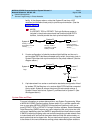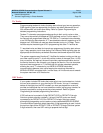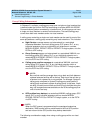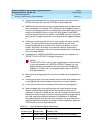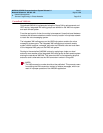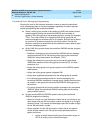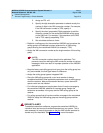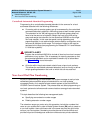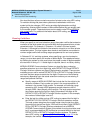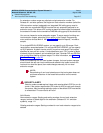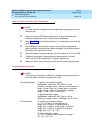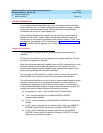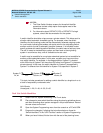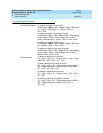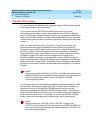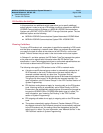
MERLIN LEGEND Communications System Release 6.1
Network Reference
555-661-150
Issue 1
August 1998
Network Management
Page 5-16Non-Local Dial Plan Numbering
5
Non-local dial plan calls are routed over pools of private trunks using UDP routing.
To maintain existing dial plans when systems are networked or when one
system’s dial plan changes, UDP routing provides digit absorption and digit
prepending, allowing dialed numbers to be modified before they are actually sent
to the remote system. These techniques can be used to route DID and PRI dial-
plan routed calls. For additional information about UDP routing, see “Switch
Identifiers” on page 19.
Planning Guidelines 5
When you specify a non-local extension range, the system verifies that extension
numbers on the local system do not conflict with those programmed on a private
networked switch. For example, if Extension 110 exists in the local system,
Extension 1100 cannot be included in the extension range for a non-local private
networked system. The local system also checks to see whether new extension
number ranges conflict with existing ranges programmed for non-local systems.
In Release 6.0 V11 and later systems, when specifying a non-local extension
range, you must also specify the number of dialed digits. This speeds call setup
by allowing the system to route a call when the proper number of digits expected
are received. An entry of 1-11 dialed digits is required; there is no factory setting.
MERLIN LEGEND Communications System non-local dial plan numbering
specifies extensions up to four digits long, while DEFINITY ECS and DEFINITY
ProLogix Solutions systems may have 5-digit extension numbers. There are two
methods you can use to number DEFINITY ECS or DEFINITY ProLogix Solutions
non-local dial plan ranges to match the five digits. Choose one of the following
techniques, depending upon the actual extension numbers you are entering in
ranges and potential conflicts:
■ Specify ranges in MERLIN LEGEND that include the first four digits in the
extension numbers. Each number you enter in the range represents 10
numbers in the remote 5-digit system. For example, an extension range
entered as 4321 through 4322 represents remote extensions 43210
through 43229. Users actually dial five digits. The local system recognizes
the number range by the first four digits, but sends all five digits to the
DEFINITY ECS or DEFINITY ProLogix Solutions system. In this example,
the number of dialed digits is set to 5.
■ Enter the last four digits and use UDP routing to prepend the first digit in
the DEFINITY ECS or DEFINITY ProLogix Solutions extension number.
The local system recognizes the number range using the last four digits.
Users dial only the last four digits. If DID calls must reach 5-digit DEFINITY
ECS or DEFINITY ProLogix Solutions extensions from a MERLIN
LEGEND Communications System, this method of routing should be used
but it is recommended that DID facilities be connected directly to the local
DEFINITY ECS or DEFINITY ProLogix Solutions systems. For details
about UDP routing, see “Uniform Dial Plan Routing” on page 25
. In this
example, the number of dialed digits is set to 4.



